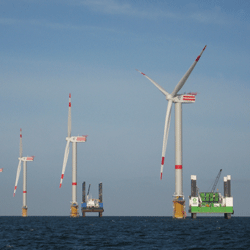 Historically, European offshore wind projects were balance-sheet financed, typically by large utilities. However, several recent European offshore wind deals have been project financed, which could signal good news for U.S. developers seeking financing for offshore wind projects.
Historically, European offshore wind projects were balance-sheet financed, typically by large utilities. However, several recent European offshore wind deals have been project financed, which could signal good news for U.S. developers seeking financing for offshore wind projects.
Eight offshore wind deals have been project financed, including two that closed in August: the 400 MW Global Tech 1 Offshore Wind Farm in Germany, and the 288 MW Meerwind project in the North Sea, which was backed by U.S. investor Blackstone, said Jerome Guillet, managing director at Paris-based financial advisory firm Green Giraffe Energy Bankers, during a session at the American Wind Energy Association's (AWEA) Offshore Wind Conference and Exhibition.
Balance-sheet financing does have some clear advantages – namely, fewer parties involved, less risk and a cheaper cost of capital, Guillet noted. However, project financing has become increasingly common, because it can reduce the amount of capital needed from an offshore wind project's sponsor, thus insulating the sponsor from risk.
‘Now that the early [project financing] precedence has been set, banks are coming to this market with more enthusiasm and capacity,’ Guillet explained, adding that because more non-utility investors are willing to invest in offshore wind, they typically need to employ the project-finance model because they lack the deep pockets of, for example, a major European utility.
According to Guillet, about 30 banks have demonstrated an appetite for risk when it comes to offshore wind projects.
In addition, the offshore wind market has been strengthened by participation from other important players, namely the major turbine manufacturers. Guillet further reasoned that the already-established presence of manufacturers such as Siemens, Vestas, Areva and REpower in Europe brings an added level of certainty to the market.
According to Brian Redmond, managing director at Boston-based CP Energy, the successful completion of offshore project-finance deals in Europe will provide a solid baseline for U.S. financing.
‘There are many areas where U.S. deals will be able to take advantage of lessons learned from Europe,’ he explained at the AWEA session. ‘Specifically, the structure of the construction contracts, equipment supply agreements, warranties and service agreements in European deals will be relevant to the U.S. market.’
In addition, European banks have already defined what information is required for due diligence and risk allocation for offshore wind.
According to Redmond, information contained in engineering and insurance reports – as well as risk allocation for weather risk, availability/performance risk during operation, and grid interruption risk – form the underpinning of the deal analysis, pricing and structuring.
‘The precedent of European bank credit committees having reviewed and/or approved offshore wind loans will help the process in the U.S,’ he said.



